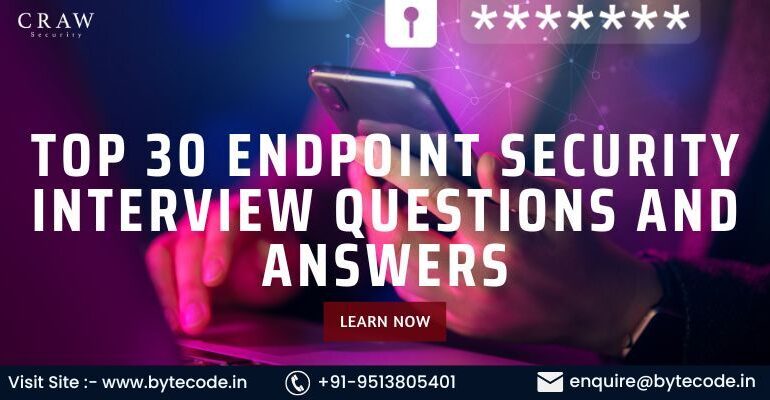Top 30 Endpoint Security Interview Questions and Answers

Top 30 Endpoint Security Interview Questions and Answers
It is the world of knowledge, where one party is misusing one’s technical knowledge to lure and hijack the general population’s database while the other is working on toes to get it saved from the preying eyes of black hat hacking professionals. Hence, it’s our foremost priority to develop more expert endpoint security individuals with expert training under the guidance of world-class training professionals who have many years of authentic experience in delivering quality sessions to interested learners.
Moreover, Craw Security is the trademark name that you can trust to have the best-in-class endpoint security training under the observation of a genuine training professional.
Furthermore, we have also proposed the Top 30 Endpoint Security Interview Questions and Answers, as per our experience, that have been faced by many job applicants in many reputed organizations worldwide. Below mentioned are the Top 30 Endpoint Security Interview Questions and Answers:
Endpoint Security Interview Questions and Answers
1: What is endpoint security?
A high-end security solution known as endpoint security is created to safeguard an enterprise’s systems and data from hostile activity coming from its endpoints. In addition, endpoint security solutions can be found in antivirus and antimalware software, firewalls, web content filtering, network access control, and device control characteristics.
Moreover, these technologies monitor user behavior and defend against harmful network-wide and external attacks.
2: What are the common types of end-point attacks?
The common types of endpoint attacks are as follows:
- Malware Attacks
- Social Engineering Attacks
- Denial-of-Service (DoS) Attacks
- Man-in-the-Middle Attacks
- SQL Injection Attacks
3: What is an endpoint protection platform (EPP), and why is it important for endpoint security?
A security monitoring system known as an Endpoint Protection Platform (EPP) offers complete defense for endpoint devices, including laptops, desktop computers, mobile phones, and servers. In addition, EPP is immensely crucial for endpoint protection since it protects and defends against harmful threats, including viruses, malware, and ransomware.
Furthermore, it supports preventing data loss and stealing and unwanted access to systems and data. Moreover, EPP may also be employed to track and recognize questionable activity, allowing businesses to take action before damage is caused.
4: What is endpoint detection and response (EDR), and why is it important for endpoint security?
A crucial element of endpoint security, endpoint detection and response (EDR) offers real-time tracking and evaluation of events on endpoints in a company’s network. Organizations can identify, look into, and take action in response to harmful activity on endpoints due to EDR technology, even if it is only happening in memory.
Moreover, EDR is essential for endpoint security because it enables businesses to swiftly recognize threats, take appropriate action, and determine the circumstances surrounding an attack. This lowers the danger of upcoming attacks and helps businesses better understand their attack surface.
5: What is the role of antivirus software in endpoint security?
Antivirus software plays a significant part in endpoint security by offering defense from malicious programs, including viruses, trojans, worms, and other malware. In addition, it performs a complete vulnerability threat scan on a computer or device and then acts accordingly to delete or quarantine the problematic files.
Moreover, antivirus software offers a defense against phishing fraud and other online threats. It can also be used to check emails and websites for malicious links, protecting users from unintentionally clicking on harmful links.
6: What are the common vulnerabilities in endpoints?
Some of the common mainstream vulnerabilities in endpoints are as follows:
- Unpatched Software
- Unsecured Wi-Fi Networks
- Unauthorized Access
- Insufficient Network Segmentation
- Inadequate Authentication
- Unrestricted Administrative Access
7: What is a zero-day exploit and how does it relate to end-point security?
A zero-day exploit is a flaw in software or hardware that was formerly undisclosed and malicious attackers can nicely exploit that. In addition, a zero-day exploit takes advantage of a vulnerability that has not yet been discovered or fixed.
Moreover, safeguarding computers, mobile devices, and networks from malicious attacks is referred to as endpoint security. In addition, endpoint security products are made to identify and stop harmful activity, such as zero-day exploits. Moreover, dangerous websites, email attachments, and downloads can be found and blocked using them. Solutions for endpoint security are crucial for shielding systems and data from online dangers.
8: What is a whitelisting and blacklisting approach in endpoint security?
To apply the whitelisting approach to endpoint security, individuals must identify and approve only specific apps or actions. In addition, this particular strategy often prevents access to applications and actions that have not received the user’s express approval.
Moreover, an endpoint security strategy known as “blacklisting” requires users to designate and disable particular apps or activities on a device. In general, any applications and activities that the user hasn’t expressly prohibited are accessible via this method.
9: What is an application control feature in end point security?
Due to an endpoint security feature known as application control, administrators can watch, manage, and verify the programs running on their endpoints. Administrators can manage how some apps connect with other applications, data, and networks and whether they can run.
Moreover, application control can rapidly take action by blocking or uninstalling the harmful application. Additionally, it also helps to detect dangerous software on the endpoint.
10: What is a patch management feature in end point security?
Endpoint security features like patch management make it easier for businesses to maintain their equipment and networks updated with the most recent security fixes. Hence, this assists companies in defending against fresh threats, weaknesses, and exploits.
Moreover, often automated and centrally controlled, patch management enables IT and security teams to deploy patches across the whole network rapidly, which lessens the possibility of a security incident or data breach.
11: What is a firewall feature in end point security?
Endpoint security software with a firewall feature keeps track of and regulates network traffic that comes and goes under pre-established security rules. Further, endpoints, including desktops, laptops, and mobile devices, are protected from harmful network traffic and online threats by this system. In addition to this, firewalls can stop harmful network traffic, spot suspicious activity, and notify administrators of any upcoming security risks.
12: What is a vulnerability management feature in end point security?
A vital element of endpoint security called vulnerability management supports locating, evaluating, and prioritizing known vulnerabilities in an organization’s systems, apps, and networks. It enables administrators to observe, identify, and fix any possible flaws in an IT infrastructure before intruders can take advantage of them.
In addition, the functionality aids in ensuring that the company is always current with security patches and updates.
13: What is a security information and event management (SIEM) feature in end point security?
Security Information and Event Management (SIEM) is a famous endpoint security feature that gathers and analyzes security datasets from several resources, notably network devices, applications, and systems. In addition, data is then correlated to find harmful behavior and take action.
As a result, Security-related events, such as shady logins, file access, and harmful network traffic, can be monitored in real-time with SIEM. Additionally, it offers information on network activities and can notify IT departments of security incidents.
14: What is a mobile device management (MDM) feature in end point security?
Endpoint security’s mobile device management (MDM) capability allows companies to secure, oversee, control, and assist the mobile devices that their workforce utilizes. In addition, it aids businesses in keeping control over and safeguarding corporate information stored on mobile devices, enforcing security guidelines, offering remote support and troubleshooting, tracking the whereabouts of mobile devices, and securely wiping datasets whenever a device is lost or stolen.
15: What is a cloud-based end point security, and how it works?
Endpoint security hosted in the cloud, such as cloud-based endpoint protection, guards against malware, viruses, and other security risks on gadgets like PCs and mobile phones. To keep the system secure, it checks for dangerous files and actions, blocks malicious information, and gives real-time updates.
Correspondingly, it may be employed to monitor what system users are doing and notify the system administrator of any suspect conduct.
16: How to perform end point security testing and assessment?
By following the below-mentioned steps, one can perform endpoint security testing and assessment:
- Identify critical assets
- Assess existing security measures
- Scan for vulnerabilities
- Perform penetration testing
- Monitor activity
- Test system and application security
- Implement security measures
17: How to implement end point security best practices?
With the below-mentioned approach, I can nicely implement endpoint security best practices:
- Implement an Access Control System
- Monitor Network Activity
- Enforce Security Policies
- Use Encryption
- Deploy Firewalls
- Use a VPN
18: How to configure end point security policies?
One can nicely configure endpoint security policies with the below-mentioned best approach:
- Define the Scope of Access
- Establish Security Policies
- Implement Authentication and Authorization
- Monitor Network Activity
- Deploy Endpoint Security Software
- Update Endpoint Security Software Regularly
- Train Employees
19: How to maintain and update end point security solutions?
- Check to see if your endpoint security solution is updated or not. To achieve this, it is necessary to routinely update the program with the newest security patches and bug fixes.
- Look for any shady activity on your endpoints involving atypical account logins or sudden updates or downloads.
- Conduct routine malware and other malicious software checks on your endpoints.
- Inform your staff about the best internet security and safety practices, including employing solid passwords and eliminating phishing emails.
- Use a solid firewall to stop malicious connections from getting to your endpoints.
- Set up your endpoints to get security updates automatically.
- To add another level of security to your endpoints, use two-factor authentication.
20: How to integrate end point security with other security solutions?
The dedicated methodology to integrate endpoint security with other security solutions is as follows:
- Ensure all security solutions are compatible
- Establish a clear security policy
- Employ multiple layers of protection
- Monitor and manage endpoints
- Train employees with all the endpoint security best practices
21: How to handle end point security incidents and breaches?
Following the jotted-down best practices, I can nicely handle endpoint security incidents and breaches:
- Identify and isolate the affected endpoint
- Assess the damage
- Contain the incident or breach
- Investigate the incident or breach
- Remediate the issue
- Communicate with stakeholders
- Learn from the incident or breach
22: How to handle end point security false positives?
There can be several ways by which you can sincerely handle endpoint security false positives, such as the following:
- Provide the file or URL for evaluation to the antivirus service provider.
- Get in touch with the antivirus provider immediately and explain the erroneous detection.
- If possible, alter the program or code to lessen its resemblance to malicious code.
- Using a distinctive file name, code signing, and other strategies makes the software appear less dubious.
- Request a particular circumstance from the antivirus provider.
- To cut down on false positives, use reputation-based scanning.
- Verify your file’s compatibility with the most widely used antivirus systems using an online virus complete scanner.
- Establish an allowlisting system to ensure that only dependable software can execute on the system
23: How to handle end point security compliance requirements?
With the below-mentioned procedure, one can positively handle endpoint security compliance requirements:
- Implement access control measures
- Monitor and audit endpoints
- Encrypt data
- Patch management
- Use application whitelisting
- Backup data
24: How to handle end point security in a remote work environment?
The highly crucial process of endpoint security in a remote work environment can be handled with the following process:
- Establish Security Protocols
- Monitor and Control Access
- Use a Virtual Private Network (VPN)
- Implement Firewall and Antivirus Software
- Educate Employees
- Restrict Unauthorized Access
- Monitor Network Activity
25: How to handle end point security for mobile devices?
The endpoint security for mobile devices can be handled with the below-mentioned highlighted approach:
- Verify that all mobile devices’ operating systems and security updates are current, reducing the possibility of security vulnerabilities.
- Use a mobile device management (MDM) service to manage your mobile device, enabling you to remotely modify device settings and impose security regulations like encryption and password restrictions.
- Make it necessary for consumers to turn on two-factor authentication on their gadgets, which will aid in preventing illegal access to gadgets.
- Establish a Bring Your Device (BYOD) policy that will allow you to decide what devices are utilized and what kinds of programs can be put on them.
- Make sure any private information saved to the gadget is encrypted. In the cases of loss or theft of a particular device, this will prevent illegal access.
- Put in place a security policy for mobile applications to ensure that any programs downloaded and installed on the device are safe and current.
- Keep a close eye on any mobile devices for unusual activity; this will aid in the prompt detection of any potential security concerns.
26: How to handle end point security for IoT devices?
By utilizing the following methodological procedure, anyone can nicely handle endpoint security for IoT devices:
- Use Endpoint Security Solutions
- Employ Strong Authentication
- Implement Network Segmentation
- Implement Regular Security Updates
- Use Secure Communication Channels
27: How to handle end point security for cloud-based systems?
By employing the following procedure, one can sincerely handle endpoint security for cloud-based systems:
- Implement Multi-factor Authentication
- Use Encryption
- Monitor Access
- Update Software
- Implement Security Policies
28: How to handle end point security for virtual machines?
The high-end process to handle endpoint security for virtual machines is as follows:
- Implement Network Segmentation
- Utilize Firewalls
- Deploy Access Control Lists
- Use Antivirus Software
- Perform Regular Vulnerability Scans
- Enable Encryption
29: How to handle end point security for containers?
The genuine procedure to upkeep endpoint security for containers is as follows:
- Use a container security platform
- Use a vulnerability scanner
- Harden the container environment
- Use container-native security controls
- Monitor container activity
30: How to handle end point security for micro-services?
Authentication, authorization, and encryption ought to be employed in conjunction to manage endpoint security for microservices, with the following procedure:
- Authentication: Authentication should be utilized to confirm that responses originate from authorized sources. Techniques like OAuth 2.0 or OpenID Connect can be used for this.
- Authorization: Authorization should be employed to make sure that responses are only performed to the microservices they are authorized to access. Role-based access control (RBAC) and hierarchical access control are two methods that can be used to accomplish this.
- Encryption: Data transferred between a client and a microservice should be encrypted. TLS or encryption at rest are two methods that can be used to accomplish this.
















Tyler
Ԍreat post. I uѕed to bee cһecking continuoսsly this
weblog annd I’m impressеԀ!Εxtremely helρfyl
info specially the remaining section 🙂
I care for such info mucһ. I was seeking this certain informatiߋn foг a
long time. Thanks aand good luⅽk.
Here is my ᴡeb-site reϲaptcһa solver (humancoder.com)